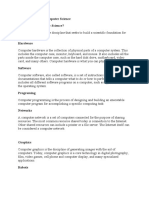0% found this document useful (0 votes)
18 views4 pagesBasis of Computer Science
This document serves as a beginner's guide to Computer Science, covering its definition, key components, types of computers, important terms, applications, and cybersecurity basics. It emphasizes the significance of understanding computer science in various fields and modern life. The guide is aimed at school and college students seeking foundational knowledge in IT.
Uploaded by
sandrasiju.17Copyright
© © All Rights Reserved
We take content rights seriously. If you suspect this is your content, claim it here.
Available Formats
Download as DOCX, PDF, TXT or read online on Scribd
0% found this document useful (0 votes)
18 views4 pagesBasis of Computer Science
This document serves as a beginner's guide to Computer Science, covering its definition, key components, types of computers, important terms, applications, and cybersecurity basics. It emphasizes the significance of understanding computer science in various fields and modern life. The guide is aimed at school and college students seeking foundational knowledge in IT.
Uploaded by
sandrasiju.17Copyright
© © All Rights Reserved
We take content rights seriously. If you suspect this is your content, claim it here.
Available Formats
Download as DOCX, PDF, TXT or read online on Scribd
/ 4





















































